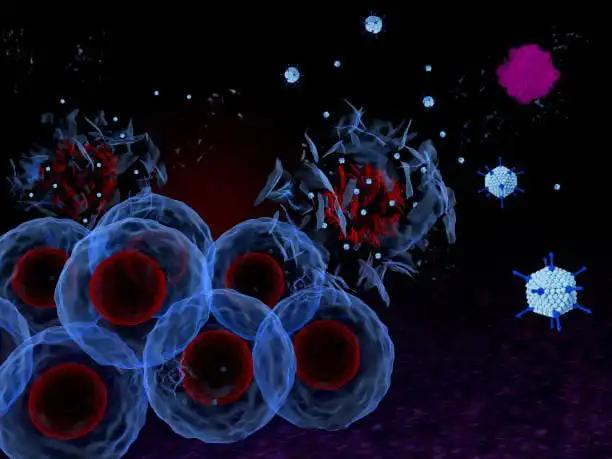KEY TAKEAWAYS
- A randomized, open-label, phase 3 (PARADIGM) trial compared the efficacy of panitumumab vs bevacizumab to regular first-line chemotherapy for RAS wild-type, left-sided, metastatic colorectal cancer.
- A total of 823 patients were enrolled in the trial and treated with mFOLFOX6 every 14 days; 411 patients received panitumumab, and 412 received bevacizumab as first-line therapy.
- Adding panitumumab to chemotherapy resulted in a higher overall survival for patients with left-sided tumors, a higher response rate, and a higher curative resection rate.
- The study followed up with patients for an average of 61 months. Common side effects of treatment included acneiform rash, peripheral sensory neuropathy, and stomatitis.
- The study showed that adding panitumumab to standard first-line chemotherapy improves OS in RAS wild-type metastatic colorectal cancer, especially in left-sided tumors.
Anti-epidermal growth factor receptor (anti-EGFR) or anti-vascular endothelial growth factor (anti-VEGF) monoclonal antibodies are routinely added to first-line doublet chemotherapy for patients with RAS wild-type metastatic colorectal cancer, although the optimal targeted therapy has not been determined. Researchers aimed to compare the efficacy of combining regular first-line chemotherapy for RAS wild-type, left-sided, metastatic colorectal cancer with the addition of panitumumab (an anti-EGFR monoclonal antibody) vs. bevacizumab (an anti-VEGF monoclonal antibody) in this study. A total of 823 patients with chemotherapy-naive RAS wild-type unresectable metastatic colorectal cancer were enrolled in a randomized, open-label, phase 3 clinical trial in Japan from May 2015 to January 2022 (last follow-up, January 14, 2022). Modified fluorouracil, l-leucovorin, and oxaliplatin (mFOLFOX6) every 14 days; panitumumab (n = 411) or bevacizumab (n = 412) as first-line therapy. Patients with left-sided malignancies were examined for the primary endpoint, overall survival, before the study was expanded to the general population. The secondary end goals were the progression-free survival, response rate, response duration, and curative (classified as R0 status) resection rate.
The majority of the tumors (604) were located on the left side of the body in the as-treated group (n = 802; median age, 66; 282 [35.2%] women). The average length of time people were followed up was 61 months. Participants with left-sided tumors had a median overall survival of 37.9 months when treated with panitumumab compared to 34.3 months when treated with bevacizumab (hazard ratio [HR] for death, 0.82; 95.798% CI, 0.68-0.99; P =.03) and 36.2 months compared to 31.3 months, respectively when treated with panitumumab. Patients with left-sided tumors had a median progression-free survival of 13.1 months with panitumumab compared to 11.9 months with bevacizumab (HR, 1.00; 95% CI, 0.83-1.20) and 12.2 months with panitumumab compared to 11.4 months with bevacizumab (HR, 1.05; 95% CI, 0.90-1.24). Panitumumab had a higher response rate than bevacizumab (74.9% vs. 67.3%) and a higher response rate for left-sided tumors (80.2% vs. 68.6%; difference, 11.2%; 95% CI, 4.4%-17.9%). Compared to bevacizumab, the median duration of response with panitumumab was 13.1 months for left-sided tumors and 11.9 months overall (HR, 0.89; 95% CI, 0.74-1.06). When comparing panitumumab and bevacizumab, the curative resection rates were 18.3% and 11.6% for left-sided tumors (difference, 6.6%; 95% CI, 1.0%-12.3%) and 16.5% and 10.9%, respectively, for all tumor sites. Acneiform rash (panitumumab: 74.8%; bevacizumab: 3.2%), peripheral sensory neuropathy (panitumumab: 70.8%; bevacizumab: 73.7%), and stomatitis (panitumumab: 61.6%; bevacizumab: 40.5%) were frequently reported side effects associated with treatment. When added to regular first-line chemotherapy for patients with RAS wild-type metastatic colorectal cancer, panitumumab dramatically increased overall survival for those with left-sided tumors and the entire patient population.
Source:https://pubmed.ncbi.nlm.nih.gov/37071094/
Clinical Trial:https://clinicaltrials.gov/ct2/show/NCT02394795
Watanabe J, Muro K, Shitara K, Yamazaki K, Shiozawa M, Ohori H, Takashima A, Yokota M, Makiyama A, Akazawa N, Ojima H, Yuasa Y, Miwa K, Yasui H, Oki E, Sato T, Naitoh T, Komatsu Y, Kato T, Hihara M, Soeda J, Misumi T, Yamamoto K, Akagi K, Ochiai A, Uetake H, Tsuchihara K, Yoshino T. Panitumumab vs Bevacizumab Added to Standard First-line Chemotherapy and Overall Survival Among Patients With RAS Wild-type, Left-Sided Metastatic Colorectal Cancer: A Randomized Clinical Trial. JAMA. 2023 Apr 18;329(15):1271-1282. doi: 10.1001/jama.2023.4428. PMID: 37071094; PMCID: PMC10114040.



